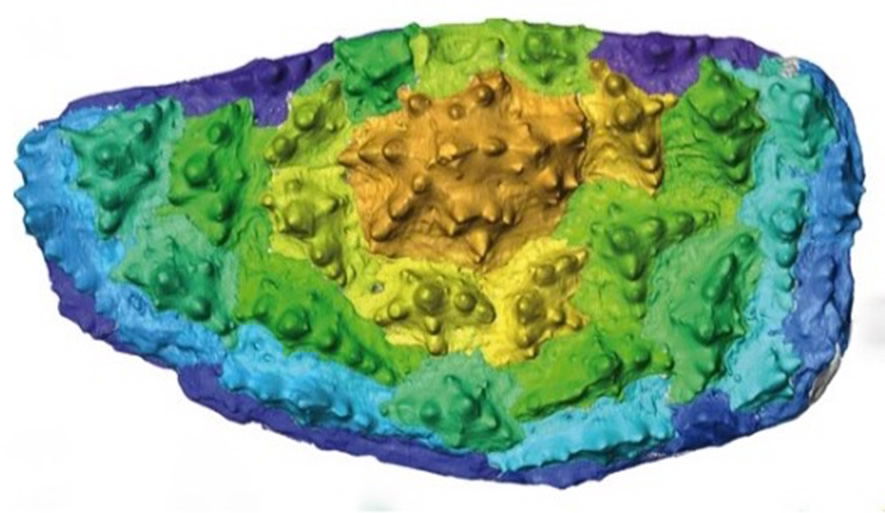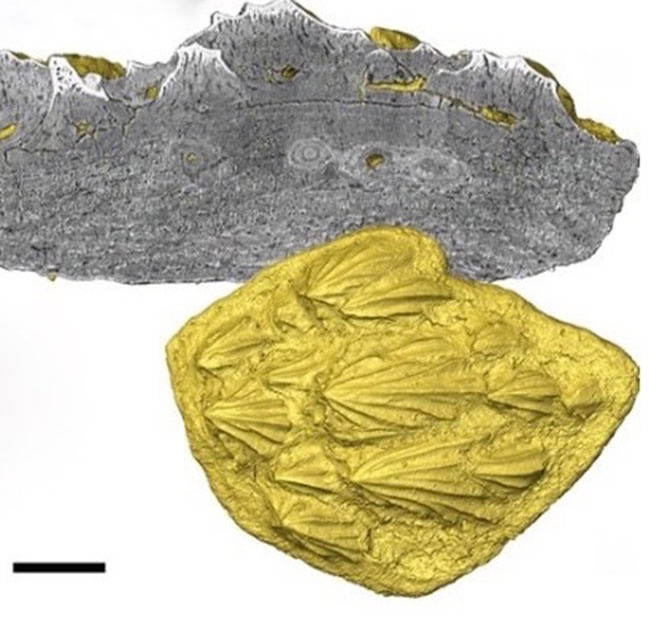
How Did We Get Our Teeth?
News to Know
Abstract
Smile! God’s Word confirms you do not have a scaly history.
News Sources
- ScienceDaily: “Forgotten Fossil Indicates Earlier Origin of Teeth”
- Phys.org: “Four Hundred Million Year Old Fish Fossil Has Earliest Example of Teeth”
- Discovery News: “First Known Teeth Belonged to Fierce Fish”
How did we—and every other toothed vertebrate on Earth—get teeth? Enquiring evolutionists want to know! In fact, they have been debating that question for some time. The discovery of teeth in a small extinct fish called Romundina has put a fresh face on the evolutionary story of how we got our smiles.
The Better to Eat You With, My Dear . . .
Cartilaginous fish like sharks have tooth-like scales covering their bodies. Those placoid scales are called “denticles.” Unlike teeth, they fill in the gaps created on the animals’ outer surface as it grows. Like teeth, however, placoid scales have an inner layer of dentine around a soft pulp and an outer covering of a hard enamel-like material. In fact, regardless of shape, the scales of many fish both extinct and extant typically have an internal composition resembling teeth, with a bony core of dentin and a covering of layers of hard enamel or enamel-like material. Therefore, evolutionists generally maintain that scales and teeth share an evolutionary history. However, for evolutionists the question remains: Which evolved first—teeth or scales?
“Inside-out” is the notion that teeth evolved very early and that scales later evolved from teeth. The “inside-out” hypothesis came into vogue because the teeth of conodonts—jawless eel-like animals—are scattered throughout the fossil record down to the Cambrian explosion. As evolutionist Neil Shubin remarked in his book Your Inner Fish: A Journey into the 3.5-Billion-Year History of the Human Body, “For years, paleontologists have argued about why hard skeletons, those containing hydroxyapatite, arose in the first place.1 For those who believed that skeletons began with the backbones, or body armor [like scales, for example], conodonts provide an ‘inconvenient tooth’ if you will. The first hydroxyapatite-containing body parts were teeth. Hard bones arose not to protect animals but to eat them.”2

This color-enhanced representation of the roof of Romundina stellina’s mouth shows numerous multicuspid enamel-capped teeth embedded in a tooth plate. The lines of arrested growth on the small specimen, less than 2mm in length, were used to determine the order in which the teeth developed during the animal’s lifetime. The teeth grew along with the bony plate on which they are mounted in an increasing circumferential pattern, as indicated with colors from gold to purple. Image reproduced from Martin Rücklin and Philip C.J. Donoghue, “Romundina and the Evolutionary Origin of Teeth,” Biology Letters 11, no. 6 (June 24, 2015), doi:10.1098/rsbl.2015.0326.

This is one of Romundina stellina’s scales. The scale—like modern fish scales—has a layered enamel-like covering, shown in yellow on the scales embedded in the cross-sectional view of the fish’s skin (top) and in the view looking down on the fish’s scale-covered back (below). Scale bar = 224 micrometers. Image reproduced from Rücklin and Donoghue, “Romundina . . . " doi:10.1098/rsbl.2015.0326.
Inside, Outside, Upside Down3
Eventually, upon discovery that some conodont teeth—the deeper ones in the fossil record—lacked enamel, the popular “inside-out” hypothesis began giving way to the notion that fish scales arose first and evolved into teeth. That’s called the “outside-in” hypothesis.
University of Bristol paleontologist Philip Donoghue, one of the scientists who pushed the outside-in hypothesis to the headlines in 2013–2014, now reports what he considers to be more support for the outside-in version of dental history: the discovery of a placoderm with teeth. A placoderm is an extinct armored fish with jaws. The fish also had scales that were similar to its teeth in composition though very different in shape.4 Donoghue and Rücklin report in Biology Letters that they have, in the placoderm Romundina stellina, found the oldest true enamel-covered teeth in vertebrate history and can trace how and when teeth evolved from scales. They expect further research to reveal whether this was the “one true tooth”5 that put vertebrates on the dental high road or whether evolution produced the innovation many times.
Did This Placoderm Evolve the First True Tooth?
Donoghue and Rücklin found the Romundina stellina fossil with teeth in a box of fossils collected four decades ago on Canada’s Prince of Wales Island. This specimen comes from Devonian rock dated 410 million years old. They examined the small fossilized fragment from the roof of the fish’s mouth using high-resolution X-ray imaging and found many complex tiny teeth with multiple pointy cusps. Romundina stellina’s teeth are not arranged like those in our smiles but are instead arranged in a whorl-like pattern on a bony plate that forms the roof of the mouth. The tooth-covered surface was likely more suited to crushing and shredding than chewing. And unlike the teeth in some other kinds of placoderms, these teeth were capped by hard layers of an enamel-like material.
Romundina’s teeth have the same composition as modern vertebrate teeth, having a dentin core and layers of enameloid. “We were able to visualize the finest internal structures and distinguish tissues inside one of the first tooth plates,” explains lead author Martin Rücklin.6 Furthermore, by showing the internal structure of each tooth and the underlying bony plate, the tomographic X-ray imaging techniques revealed how the teeth likely grew during the fish’s life. Rücklin says, “With powerful computing we combined thousands of X-rays and produced computer models reconstructing the growth of the first teeth.”7 Based on the arrangement of growth arrest lines throughout the full thickness of the bony plate, it appears the teeth developed circumferentially around an initial “pioneer tooth,” developing in tissue near the edge of the bony plate. The bony plate looks like it expanded as teeth were added to it.8
Currently evolutionists imagine that the ancestor of all jawed vertebrates—a category that includes most fish, all terrestrial vertebrates, birds, and us —was a placoderm, the category of fish in which evolutionists believe jaws first evolved. About 8 inches long, Romundina have been found in Silurian and Devonian rock dated up to 415 million years old. Though not considered the oldest placoderm in the fossil record, Romundina is considered the most evolutionarily primitive one because it possesses—or in the evolutionists’ view “retains”—characteristics of both jawed and jawless vertebrates. Romundina, evolutionists believe, evolved from lamprey-like jawless fish. Read more about Romundina in “Fish Brains Grew Till We Have Faces, Evolutionists Say.”
Search for Origin of the One True Tooth
The X-ray images revealing the complex structure of the teeth radially arranged on Romundina’s upper jaw provide fascinating observable scientific information about this placoderm’s mouth. Enamel-covered teeth have not been found on other specimens of Romundina. Comparison of the teeth mounted on Romundina stellina’s upper jaw to those of other extinct fish reveals a similar arrangement of simpler teeth on the jawless thelodont fish Loganellia. Other sorts of placoderms such as Compagopiscis exhibit teeth arranged in orderly rows but lacking enamel. The absence of enamel on the teeth of other placoderms suggests, the researchers believe, that placoderms all originally had enamel and lost it over time. Of course, if some placoderms lost their ability to produce enamel over time—a possibility—that would not be uphill evolution but only a loss of information. The variations found in the teeth of extinct fish are no indication that either teeth or enamel had to evolve.
Romundina stellina’s scales, like its teeth, are also unusual for placoderms. Unlike those of most other placoderms but like modern placoid scales and those of the extinct jawless armored fish known as ostracoderms—Romundina stellina’s scales had an enamel-like covering. And though their internal composition was essentially the same, the shapes of the scales and teeth were quite distinct.9 Again, this does not demonstrate that there is an evolutionary relationship between scales and teeth.
Donoghue and Rücklin are confident that teeth evolved from scales and believe their data supports this “outside-in” version of dental history. They believe the teeth in Romundina stellina have now provided a way to map the evolutionary development of teeth from scales over deep time. Hard protective layers of enamel-like material, they suspect, is the key. The authors note that whether teeth are found in jawed or jawless animals, whether they are multi-cusped or smooth, radially arranged or arranged in rows—there seems to be a pattern in that the presence of enamel on a fish’s teeth is generally associated with the presence of enamel on its scales.
“Our data show that teeth and scales of Romundina are made of the same tissues, and these are also found in our teeth,” Rücklin explains. “This is in agreement with the idea that scales evolved first and teeth derived from them.”10 Donoghue adds, “We show that the earliest teeth were like our own—but also structured like body scales in primitive fishes. This supports the view that teeth evolved from scales, which arose much earlier in vertebrate evolution.”11
“Our results suggest that teeth originated deeper in the tree of life than we thought,” explains Rücklin.12 Whether the evolution of the one true tooth set the course of vertebrate evolution on its toothy path or whether teeth evolved more than once is the issue they wish to clarify. Because both jawless animals like conodonts and jawed animals like Romundina had true teeth, they believe jaws evolved independently of teeth, the latter springing very early in history from the evolutionary foundation of scales. “We will have to look into more basal jawed vertebrates and also jawless fossils,” Rücklin explains. “Earliest jaws and teeth seem to be less integrated than we thought and teeth look more complex than expected.” He is pleased that he has received a grant to further “investigate these early stages of teeth and how the complex system of our own jaws and teeth evolved.”13
Right for the Wrong Reasons
The evolutionary scientists involved in the study are confident that they have put to rest both the “inside-out” hypothesis and any connection between the origins of teeth and the vertebrate jaw. And here they are right, but for the wrong reasons! We would agree that scales did not evolve from teeth and that the origin of the vertebrate jaw had nothing to do with the evolution of teeth. However, they have only replaced the previously popular evolutionary idea with equally unverifiable evolutionary notions: that the jaw evolved independently and that teeth evolved “outside-in” from scales.
By comparing the assortment of features found in various fish, extant and extinct, evolutionists draw speculative and unverifiable conclusions about how one kind of animal evolved from another. However, the discovery of an animal with complex, modern-appearing teeth radially arranged in this fish of very little face deep in the fossil record does not demonstrate that fish were sporting freshly evolved enamel-covered teeth to which we should credit our own smiles. Likewise the fact that scales and teeth have similar internal composition fails to reveal an evolutionary connection between them. God our Creator chose to use enamel-coated teeth and scales in the design of a variety of animals; enamel did not have to evolve, neither sooner nor later. The existence of these teeth and their enamel does not reveal their origins. But the history provided by God in His Word does.
God created all kinds of animals as well as the first two human beings, in the space of just two days, about 6,000 years ago, according to His own eyewitness testimony. No scientist was there, and God’s eyewitness account of creation and other pivotal events early in our history—such as the global Flood—are consistent with the observations of science. Billions of organisms buried in the fossil record represent a timeline of their own catastrophic destruction, many of them during that global Flood of Noah’s day, not a timeline of their evolutionary emergence over millions of years. (Read more about how worldview-based evolutionary assumptions superimposed on the fossil record create their own evolutionary conclusions, even though observable biology reveals no way that one kind of animal can evolve into a new and different kind of animal in “Doesn’t the Order of Fossils in the Rock Record Favor Long Ages?”) It is no surprise to find that many different sorts of animals with teeth and scales are preserved in the fossil record, but that does not reveal they had an evolutionary relationship. Romundina’s complex, modern-appearing teeth and scales do not reveal their origin, but their preservation after catastrophic burial during the global Flood reveals one of the good designs of the Creator God who was wise enough to create all sorts of animals fully functional from the very beginning.
Further Reading
For More Information: Get Answers
Remember, if you see a news story that might merit some attention, let us know about it! (Note: if the story originates from the Associated Press, FOX News, MSNBC, the New York Times, or another major national media outlet, we will most likely have already heard about it.) And thanks to all of our readers who have submitted great news tips to us. If you didn’t catch all the latest News to Know, why not take a look to see what you’ve missed?
(Please note that links will take you directly to the source. Answers in Genesis is not responsible for content on the websites to which we refer. For more information, please see our Privacy Policy.)
Footnotes
- Dentin, which surrounds a tooth’s pulp and is capped by enamel, is a bony tissue that is, by weight, composed of about 70% hydroxyapatite.
- Neil Shubin, Your Inner Fish: A Journey into the 3.5-Billion-Year History of the Human Body (New York: Pantheon Books, 2009), ch. 4.
- The delightful and similarly titled 1997 Random House Berenstain Bear Bright & Early Board Book Inside Outside Upside Down (from which this subheading was loosely derived) explains simple spatial concepts to young children. But the evolutionary concepts alluded to here are, by contrast, not so simple as names like “Inside-Out” and “Outside-In” make them seem. While Berenstain Bear books explain observable facts in an understandable way, these evolutionary ideas make the march of tooth-and-scale evolution across millions of years and countless different kinds of organisms—unobservable notions unsupported by the observations of experimental biology—appear obvious and plausible when they are not.
- “Romundina . . . " doi:10.1098/rsbl.2015.0326.
- Last year Donoghue and Rücklin wrote, “It remains unclear, however, whether our search for the evolutionary origin of teeth is a search for the evolutionary appearance of the one true tooth, or whether teeth evolved independently in a number of distinct lineages of jawed stem‐ and crown‐gnathostomes through the cooption of oral/pharyngeal denticles to a tooth function.” From “The Ins and Outs of the Evolutionary Origin of Teeth,” Evolution & Development (September 15, 2014): 1–12, doi:10.1111/ede.12099.
- Naturalis Biodiversity Center, "Forgotten Fossil Indicates Earlier Origin of Teeth," ScienceDaily, June 24, 2015, http://www.sciencedaily.com/releases/2015/06/150624090603.htm.
- Ibid.
- The toothplates from the “placoderm Romundina stellina comprise multicuspid teeth, each composed of an enameloid cap and core of dentine. These were added sequentially, approximately circumferentially, about a pioneer tooth. Teeth are bound to a bony plate that grew with the addition of marginal teeth. . . . The tomographic data also reveal clearly that the tubercles were added episodically to the margins of the gnathal plate, evidenced by growth arrest lines that occur between tubercles that developed on the margins of older, earlier formed, tubercles ( figure 2b – d). These growth lines can be traced continuing through the middle and basal layers, demonstrating that the bony plate grew in width and thickness in association with the addition of tubercles at the margins.” From Rücklin and Donoghue, “Romundina . . ." doi:10.1098/rsbl.2015.0326.
- “The surface morphology of the tubercles comprising the supragnathal in Romundina is quite distinct from the morphology of the dermal tubercles, though they have a common composition.” From Rücklin and Donoghue, “Romundina . . ." doi:10.1098/rsbl.2015.0326.
- Jennifer Viegas, “First Known Teeth Belonged to Fierce Fish,” Discovery News, June 23, 2015, http://news.discovery.com/animals/first-known-teeth-belonged-to-fierce-fish-150623.htm.
- Naturalis Biodiversity Center, “Forgotten Fossil . . .”
- Ibid.
- Ibid.
Recommended Resources

Answers in Genesis is an apologetics ministry, dedicated to helping Christians defend their faith and proclaim the good news of Jesus Christ.
- Customer Service 800.778.3390
- © 2024 Answers in Genesis



